Climate Change: Facts and Impacts (part 3 of 4)
What changes do we expect?
The answer to this question is complex. I will limit my attempt to answer this question by making one big assumption: Abrupt Climate Change will not occur. This assumption is useful for me because I can explain the known impacts of ‘business as usual’ relatively easily. This is not a luxury that policy makers or economists have, if they are acting responsibly. Just as businesses ‘hedge against’ uncertainties and take out insurance policies so policy makers need to hedge against the chance of abrupt climate change. The shut down of the gulf stream for example is of uncertain probability but a 10% chance is the level at which many climate scientists regard this occurrence. As Richard Alley, one of the world’s top climate scientists points out:
Like the IPCC I will focus on smooth climate change of the magnitude thought most likely; significantly worse outcomes are possible. Most importantly however, virtually all of this can be avoided by rapid, co-coordinated and determined international action. I will later describe the level of emissions cuts required and compare this to the climate policy of the UK government.
Cryosphere
The Cryosphere is set for a rapid decline during the coming century. Virtually all tropical and temperate glaciers are set to disappear and the arctic will be enormously reshaped. Some have pointed out that this will open the arctic up to shipping, they are right. But the polar bears, the seals and the peoples of the arctic may not see this as just compensation for there extinction and loss of cultural heritage! As I will show later, the decline of the cryosphere will lead to an extension of the oceans, much to the detriment of costal communities the world over.
Another potentially very dangerous effect of warming in the arctic is the thawing out of vast areas of permafrost (fig.17). There are significant stores of methane locked up in, and trapped below the permafrost regions of the high Arctic. The release of billions of tones of this methane, which has around 23 times the global warming potential of carbon dioxide, could cause devastating positive feedback and further accelerate warming.
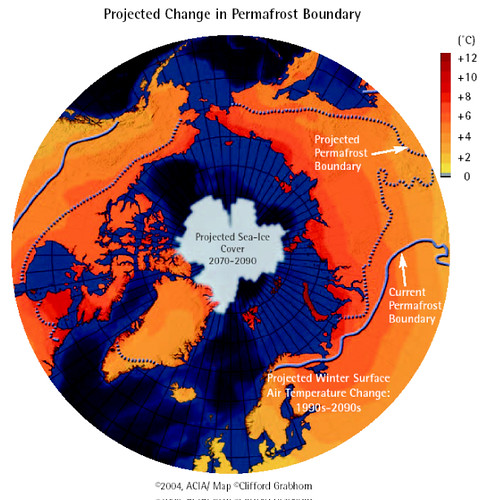
Fig 20
The predicted loss of sea ice is shown below, the pristine wilderness of the arctic will no longer be traversed by the occasional adventurer, walking to the north pole will no longer be an option, sailing to it may be.
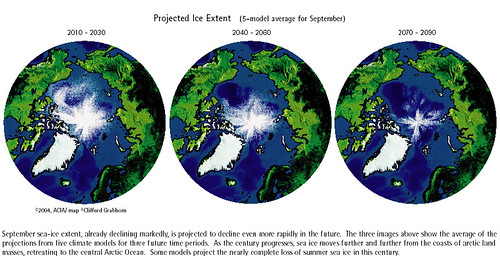 Fig 20
Fig 20
Oceans
The National Oceanic and Atmospheric Administration (NOAA) have carried out research that indicates the likely effects of further climate change. The NOAA point out that many models indicate a more El Nino like climate in the future, but even if this doesn’t occur, individual events will grow in severity.
Apart from the destruction of the coral reefs one of the most significant changes for both humans and wildlife will be the rising sea level. It is thought that around one meter of sea level rise will occur before the end of the century. The cost of this, economically and environmentally can scarcely be over estimated. Many of the ecologically richest regions in the world are low-lying delta areas, such as the Niger delta, much of Bangladesh, and the Amazon delta. The impact that this will have on Florida can be seen below, as can the number of people affected by flooding.
Average annual global number of people flooded for the 2020s, 2050s and 2080s under the three emissions scenarios: unmitigated (red), stabilisation at 750 ppm (blue) and at 550 ppm CO2 (green). Also shown are the numbers without climate change (grey).
These effects on Florida represent the effects of a one meter rise in sea level, over the next few hundred years it is likely that the sea will rise by around 7m and this will have dramatic impacts on costal cities around the world as well as much of the world wetland. The chart above shows the number of people flooded, based on different emission scenarios. The dramatic difference that mitigation can have is clearly apparent. Over just the next 45 years relative sea levels are set to rise by up to a meter on the Louisiana coast. Sea level increases of around 20-50 cm being typical along the coastline of the United States.
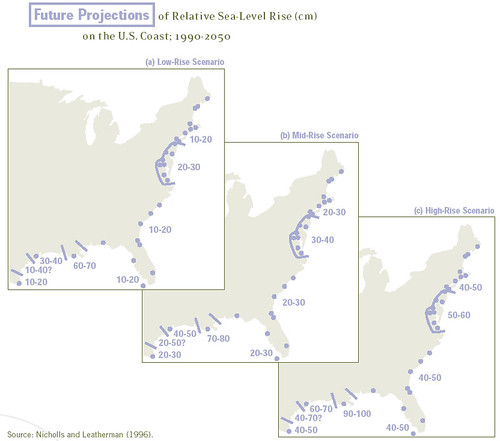
Fig 23
Weather Patterns
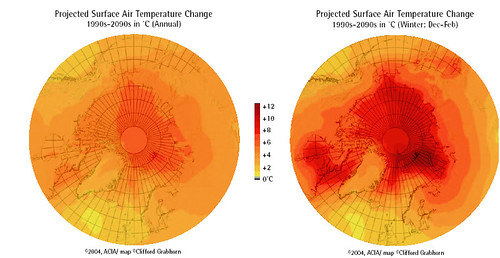
Fig 24
Other areas that are likely to suffer due to climate change related factors include large areas of India, and parts of China where the summer flow of many rivers will be drastically decreased due to the absence of glaciers in the high mountains. Much of inner china has already seen marked decrease in rainfall and large areas of formerly marginal land is now being consumed by the extension of the Gobi desert. Apart from the local inhabitants who are entirely dependent on subsistence agriculture for there livelihoods, numerous cities, including Beijing are feeling the negative health affects of the vast amounts of red dust scoured from the parched earth by the winds coming down from the Himalayan mountains and Tibetan plateau. The photos below show the effects of desertification on former farmland in China and the intensity of the dust storms that have already killed many people. This pattern of productive land loss is set to continue as climate change increases its pace. The effects we are currently seeing represent only a 0.6-0.7 degree increase in global average temperatures, the situation will be immeasurably worse with 5-8 degrees of average change, predicted by many of our current climate models for business as usual scenarios!
Figs 24,25,26,27 show: The effects of climate change on the climate of central china, desertification is pressing ahead rapidly; the ‘sight’ experienced during a red dust storm as a result of this desertification; the effects on the health of people living in Bejing, thousands of miles away from the source of the daust and finally the evidence of drying out of inland china, one of many dried out river beads.
Biosphere
The impact of climate change on the biosphere will be enormous. Temperature will change, but so will annual precipitation, precipitation distribution and intensity, relative humidity, the number and severity of storms: virtually every characteristic of a given environment will change. The predicted level of extinctions in tropical forests are shown below. A recent paper (Thomas et.al., Nature, 2004) found that warming of 0.8-1.7, 1.8-2.0 and >2.0 degrees would lead to extinction of 18%, 24% and >35% of species respectively. This paper was reviewed by J.Alan Pounds and Robert Puschendorf who pointed out that these figures may be to low, climate change doesn’t act in isolation but synergistically with other environmental pressures.
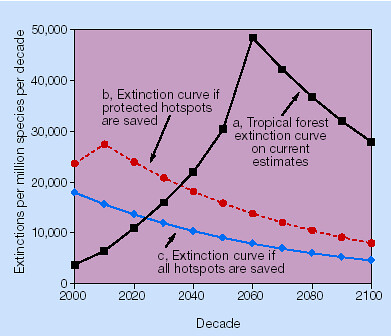 Fig 28
Fig 28
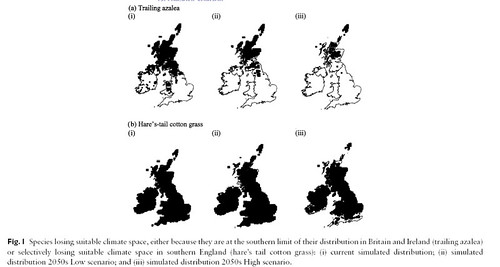 Fig 29
Fig 29
The UK environment ministry has funded research into the impacts of climate change, this program known as UKCIP has been used to predict the changes in distribution of numerous species, including the two shown above. Redistribution within the UK will probably occur readily (fig.28) but what about species in the far north that need cool temperatures? It is difficult for animals other than birds to find there way north to a more suitable climate such as Sweden.
The total number of extinctions that are likely to occur as a result of climate change depend largely on two factors, the magnitude of change and the rate of change. Species tend to be adapted to a relatively small climatic range, when climate change occurs the species will attempt to move to the area that is now optimal for its growth. There are several problems with this:
Natural Limits:
Human Limits:
Health
The future impact of climate change on health in general is going to be enormous. The WHO in their report on health and climate change published in 2002 finds that there are currently 150`000 climate change related deaths annually and they predict that this number will double by 2020. A report by the Working Group on Climate Change and Development published in June 2005 finds that:
Dr James W.Hurrell an author of the NCAR report states that:
As the charts below show the effects of climate change on human health are diverse; ranging from increased exposure to droughts and floods, an increase in the range of vector borne diseases such as malaria, increases in the number of cases of Diarrhea and an increase in starvation. Climate change must be tackled if development is to occur and failure to tackle climate change will make achievement of the UN’s Millennium Development Goals impossible.
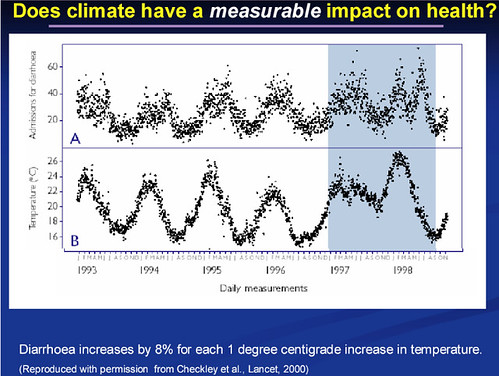
Fig 30
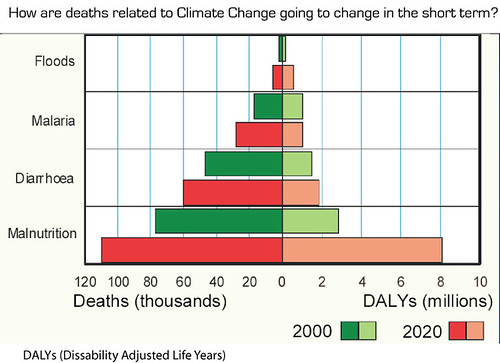 Fig 31
Fig 31
All 4 parts of this report can be downloaded in the form of a pdf document from here
main page
Home

 del.icio.us
del.icio.us

 Digg This!
Digg This!


The answer to this question is complex. I will limit my attempt to answer this question by making one big assumption: Abrupt Climate Change will not occur. This assumption is useful for me because I can explain the known impacts of ‘business as usual’ relatively easily. This is not a luxury that policy makers or economists have, if they are acting responsibly. Just as businesses ‘hedge against’ uncertainties and take out insurance policies so policy makers need to hedge against the chance of abrupt climate change. The shut down of the gulf stream for example is of uncertain probability but a 10% chance is the level at which many climate scientists regard this occurrence. As Richard Alley, one of the world’s top climate scientists points out:
"The debate in the US is usually about whether things could really be as bad as the International Panel on Climate Change (IPCC) have suggested, But; It is hard to make the IPCC scenarios better and easy to make them worse!"
Like the IPCC I will focus on smooth climate change of the magnitude thought most likely; significantly worse outcomes are possible. Most importantly however, virtually all of this can be avoided by rapid, co-coordinated and determined international action. I will later describe the level of emissions cuts required and compare this to the climate policy of the UK government.
Cryosphere
The Cryosphere is set for a rapid decline during the coming century. Virtually all tropical and temperate glaciers are set to disappear and the arctic will be enormously reshaped. Some have pointed out that this will open the arctic up to shipping, they are right. But the polar bears, the seals and the peoples of the arctic may not see this as just compensation for there extinction and loss of cultural heritage! As I will show later, the decline of the cryosphere will lead to an extension of the oceans, much to the detriment of costal communities the world over.
Another potentially very dangerous effect of warming in the arctic is the thawing out of vast areas of permafrost (fig.17). There are significant stores of methane locked up in, and trapped below the permafrost regions of the high Arctic. The release of billions of tones of this methane, which has around 23 times the global warming potential of carbon dioxide, could cause devastating positive feedback and further accelerate warming.

Fig 20
The predicted loss of sea ice is shown below, the pristine wilderness of the arctic will no longer be traversed by the occasional adventurer, walking to the north pole will no longer be an option, sailing to it may be.
 Fig 20
Fig 20Oceans
The National Oceanic and Atmospheric Administration (NOAA) have carried out research that indicates the likely effects of further climate change. The NOAA point out that many models indicate a more El Nino like climate in the future, but even if this doesn’t occur, individual events will grow in severity.
"For such El Nino-like climate change, or even for a more uniform future warming of SSTs [Sea Surface Temperatures] across the tropical Pacific as shown in some other models, future seasonal precipitation events associated with a given El Nino would be more intense than at present owing to the nonlinear relation between SST and evaporation [a little warming, a lot more evaporation]."
(David.R.Eastling et.al., Science, 2000)
Apart from the destruction of the coral reefs one of the most significant changes for both humans and wildlife will be the rising sea level. It is thought that around one meter of sea level rise will occur before the end of the century. The cost of this, economically and environmentally can scarcely be over estimated. Many of the ecologically richest regions in the world are low-lying delta areas, such as the Niger delta, much of Bangladesh, and the Amazon delta. The impact that this will have on Florida can be seen below, as can the number of people affected by flooding.
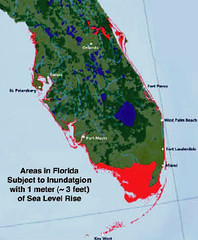 Fig 21 | 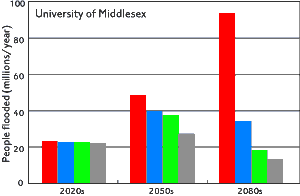 Fig 22 |
These effects on Florida represent the effects of a one meter rise in sea level, over the next few hundred years it is likely that the sea will rise by around 7m and this will have dramatic impacts on costal cities around the world as well as much of the world wetland. The chart above shows the number of people flooded, based on different emission scenarios. The dramatic difference that mitigation can have is clearly apparent. Over just the next 45 years relative sea levels are set to rise by up to a meter on the Louisiana coast. Sea level increases of around 20-50 cm being typical along the coastline of the United States.

Fig 23
Weather Patterns

Fig 24
Other areas that are likely to suffer due to climate change related factors include large areas of India, and parts of China where the summer flow of many rivers will be drastically decreased due to the absence of glaciers in the high mountains. Much of inner china has already seen marked decrease in rainfall and large areas of formerly marginal land is now being consumed by the extension of the Gobi desert. Apart from the local inhabitants who are entirely dependent on subsistence agriculture for there livelihoods, numerous cities, including Beijing are feeling the negative health affects of the vast amounts of red dust scoured from the parched earth by the winds coming down from the Himalayan mountains and Tibetan plateau. The photos below show the effects of desertification on former farmland in China and the intensity of the dust storms that have already killed many people. This pattern of productive land loss is set to continue as climate change increases its pace. The effects we are currently seeing represent only a 0.6-0.7 degree increase in global average temperatures, the situation will be immeasurably worse with 5-8 degrees of average change, predicted by many of our current climate models for business as usual scenarios!
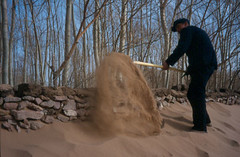 Fig 24 | 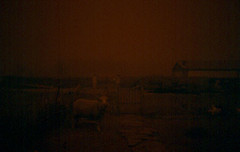 Fig 25 |
 Fig 26 | 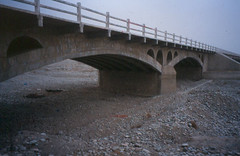 Fig 27 |
Figs 24,25,26,27 show: The effects of climate change on the climate of central china, desertification is pressing ahead rapidly; the ‘sight’ experienced during a red dust storm as a result of this desertification; the effects on the health of people living in Bejing, thousands of miles away from the source of the daust and finally the evidence of drying out of inland china, one of many dried out river beads.
Biosphere
The impact of climate change on the biosphere will be enormous. Temperature will change, but so will annual precipitation, precipitation distribution and intensity, relative humidity, the number and severity of storms: virtually every characteristic of a given environment will change. The predicted level of extinctions in tropical forests are shown below. A recent paper (Thomas et.al., Nature, 2004) found that warming of 0.8-1.7, 1.8-2.0 and >2.0 degrees would lead to extinction of 18%, 24% and >35% of species respectively. This paper was reviewed by J.Alan Pounds and Robert Puschendorf who pointed out that these figures may be to low, climate change doesn’t act in isolation but synergistically with other environmental pressures.
 Fig 28
Fig 28 Fig 29
Fig 29The UK environment ministry has funded research into the impacts of climate change, this program known as UKCIP has been used to predict the changes in distribution of numerous species, including the two shown above. Redistribution within the UK will probably occur readily (fig.28) but what about species in the far north that need cool temperatures? It is difficult for animals other than birds to find there way north to a more suitable climate such as Sweden.
The total number of extinctions that are likely to occur as a result of climate change depend largely on two factors, the magnitude of change and the rate of change. Species tend to be adapted to a relatively small climatic range, when climate change occurs the species will attempt to move to the area that is now optimal for its growth. There are several problems with this:
Natural Limits:
- Species have a limit to the rate at which they move, plants are often limited by there rate of seed distribution and animals are often limited by the requirement of having certain plant and prey species present in to feed on.
- This very heterogeneous ability of ecosystems to relocate en masse causes inevitable species loss, the degree of this loss is increased dramatically as the rate of change increases.
- Relocation is only possible if the species aren’t on an island or surrounded by mountains etc… There is often no route for species to take, particularly plants and non-flying animals.
- When it gets warmer it would seem to make sense for a plant to simply move pole ward, or uphill. Moving uphill however is not simply a matter of moving to a cooler environment it involved adapting to more acidic and less nutrient rich soils as well as adapting to higher rates of evaporation in the desiccating strong winds characteristic of upland areas.
Human Limits:
- Many valuable ecosystems are protected in their current location only, or are surrounded by human development. The enormous impacts that humans have had on the planet, from the development of large urban centers to vast tracts of carefully managed farmland mean that in many parts of the world relocation is not possible.
Health
The future impact of climate change on health in general is going to be enormous. The WHO in their report on health and climate change published in 2002 finds that there are currently 150`000 climate change related deaths annually and they predict that this number will double by 2020. A report by the Working Group on Climate Change and Development published in June 2005 finds that:
"A half century long trend of falling rainfall in Southern Africa is set to continue according to new research by the National Center for Atmospheric Research (NCAR). And it appears that the pattern is closely related to a warming of the Indian Ocean, which because it otherwise lacks the variability of the Atlantic and pacific. is reported to be a clear finger print of human caused climate change."
Dr James W.Hurrell an author of the NCAR report states that:
"In our models, the Indian Ocean shows very clear and dramatic warming into the future , which means more and more drought for Southern Africa"
As the charts below show the effects of climate change on human health are diverse; ranging from increased exposure to droughts and floods, an increase in the range of vector borne diseases such as malaria, increases in the number of cases of Diarrhea and an increase in starvation. Climate change must be tackled if development is to occur and failure to tackle climate change will make achievement of the UN’s Millennium Development Goals impossible.

Fig 30
 Fig 31
Fig 31All 4 parts of this report can be downloaded in the form of a pdf document from here
main page
Labels: africa, asia, china, India, science

Home









0 Comments:
Post a Comment
<< Home